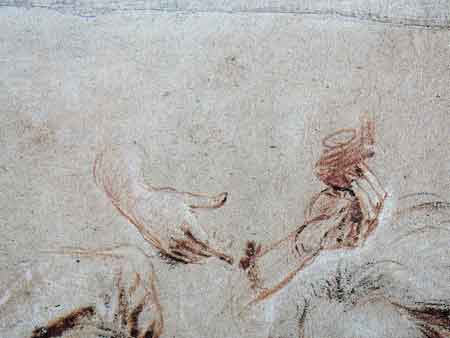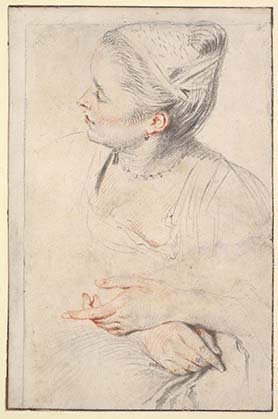
- Home Page
- Accepted
Paintings & Copies - Doubtful
Attributions - Doubtful Textual References
- Alternative
Titles - Collectors &
Museums - Bibliography
- Search Abecedario
- Watteau &
His Circle
L’Amour au théâtre italien
Entered December 2014; revised November 2015
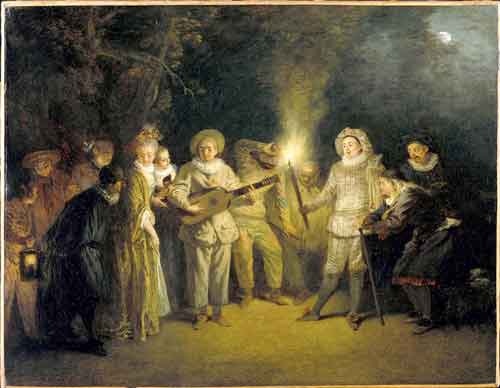
Berlin, Gemäldegalerie, inv. 470.
Oil on canvas
37 X 48 cm
ALTERNATIVE TITLES
L’Amour sur la scène italienne
The Italian Comedians
Die italienische Komödie
Italienisches Theater
Die Liebe auf der italienischen Schaubühne
Les Plaisirs de la comédie italienne
RELATED PRINTS
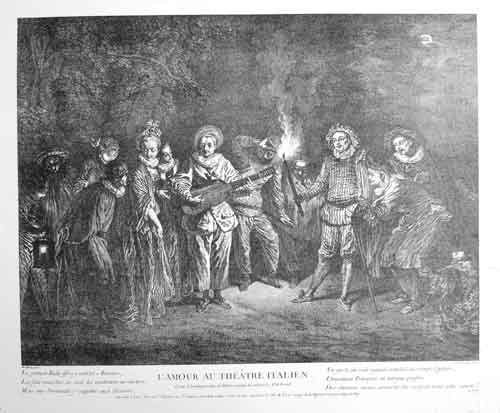
L’Amour au théâtre italien was engraved in the same direction as the painting by Charles Nicolas Cochin. The print was announced for sale in the April 24, 1734, issue of the Mercure de France (p. 940).
PROVENANCE
Paris, collection of Henri de Rosnel (d. 1739; textile merchant and échevin de Paris). His ownership is acknowledged in the caption. The picture passed to his wife Marie Thérèse Marsollier (d. 1752).
Berlin, collection of Frederick II [Frederick the Great] (1712-1786; king of Prussia). It was acquired in Paris between 1763 and 1766, and was recorded in the Österreich plan of 1766 for the hanging of the pictures in the royal collection. The painting was transferred to the Sans-Souci Palace in Potsdam in 1769 and is listed in Österreich, Beschreibung der Königlichen Bildergallerie (1770), 155, cat. 167, as Die Liebe auf der italienschen Schaubühne.” It is also cited in the French edition, Description des tableaux de la galerie royale (1771), 135, cat. 169, where it is listed under the name L’Amour sur la scene italienne.” The painting remained there until 1830. It then was rehung in the Royal Prussian Museum in Berlin, and then in the Gemäldegalerie. During World War II and afterward it was stored in Wiesbaden.
EXHIBITIONS
Paris, Musée Carnavalet, Le Théâtre à Paris (1929), cat. 77 (as by Watteau, L’Amour au théâtre italien, lent by Berlin, Kaiser-Friedrich Museum).
New York, Metropolitan Museum, Paintings from Berlin Museums (1948), cat. 142 (as by Watteau, The Italian Comedians, lent by the Royal Collections).
Wiesbaden, Landesmuseum, Französische Kunst (1951), cat. 53 (as by Watteau, Die italienische Komödie).
Paris, Petit Palais, Chefs-d'oeuvre des musées de Berlin (1951), cat. 58 (as by Watteau, L’Amour au théâtre italien, lent by Berlin, Gemäldegalerie).
Munich, Residenz, Europäisches Rokoko (1958), cat. 220 (as by Watteau, L’Amour au théâtre italien, lent by Berlin, Dahlem Museum).
Berlin, Schloss Charlottenburg, Meisterwerke (1962), cat. 96. (as by Watteau, Die italienische Komödie).
Bordeaux, Galerie des beaux-arts, Les Arts du théâtre de Watteau à Fragonard (1980), cat. 68 (as by Watteau, L’Amour au théâtre Italien, lent by Berlin, Staatliche Museen Preussischer Kulturbesitz, Gemäldegalerie).
Frankfurt, Städelsches Kunstinstitut, Einschiffung nach Cythera (1982), 68, 70, cat. Ce9 (as by Watteau, L’Amour au théâtre italien, lent by Berlin, Staatliche Museen Preussischer Kulturbesitz, Gemäldegalerie).
Braunschweig, Französische Malerei (1983), cat. 35 (as by Watteau, Die italienische Komödie, [L’Amour au théâtre italien], lent by Berlin, Gemäldegalerie).
Ottawa, National Gallery, The Age of Watteau, Chardin, and Fragonard (2003), cat. 6 (as by Watteau, L’Amour au theater français, lent by Staatliche Museen zu Berlin).
New York, Metropolitan Museum, Watteau, Music and Theater (2009), cat. 10 (as by Watteau, Love in the Italian Theater [L’amour au théâtre italien], lent by Gemäldegalerie, Staatliche Museen, Preussischer Kulturbesitz Berlin).
SELECT BIBLIOGRAPHY
Viardot, Les Musées d’Allemagne (1844), 373.
Hédouin, “Watteau” (1845), cat. 76.
Hédouin, Mosaïque (1856), cat. 77.
Lejeune, Guide théorique et pratique (1864), 1: 213.
Goncourt, Catalogue raisonné (1875), cat. 69.
Mollet, Watteau (1883), 62-63.
Fourcaud, “Scènes et figures théatrales” (1904), 199-200.
Zimmermann, Watteau (1912), pl. 35.
Alexandre, “Ce qui est à nous” (1919), 124.
Dacier, Vuaflart, and Hérold, Jean de Jullienne et les graveurs (1921-29), 1: 266; 3: cat. 271.
Seailles, Watteau (1927), 79.
Réau, “Watteau” (1928), cat. 55.
Mathey, “Remarques sur la chronologie” (1939), 160.
Brinckmann, Watteau (1943), cat. 58.
Adhémar, Watteau (1950), 44, cat. 204.
Panofsky, “Gilles or Pierrot?” (1952), 331-32.
Mirimonde,“Sujets musicaux chez Watteau” (1961), 249-288.
Nicoll, World of Harlequin (1963), 139-40.
Brookner, Watteau (1967), pl. 23.
Macchia and Montagni, L’opera completa di Watteau (1968), cat. 188.
Ferré, Watteau (1972), cat. A30.
Mirimonde, L’Iconographie musicale sous les rois bourbons (1977), 2: 110.
Ferré, Watteau (1980), cat. P 31.
Roland Michel, Watteau (1981), cat. 227.
Roland Michel, Watteau (1984), 217, 200, 272, 301.
Posner, Watteau (1984), 121, 262-63.
Macchia, “Le Mythe théâtral de Watteau” (1987), 190.
Börsch-Supan, Antoine Watteau (2000), 54-57.
Temperini, Watteau (2002), 118, cat. 98.
Rosenberg, Gesamtverzeichnis französische Gemälde (2005), cat. 1232.
Glorieux, Watteau (2011), 289.
Vogtherr, Französische Gemälde (2011), cat. B2.
RELATED DRAWINGS
Although a good number of Watteau’s drawings have been associated with L’Amour au théâtre italien, only a few can be confirmed as specifically linked with the painting.

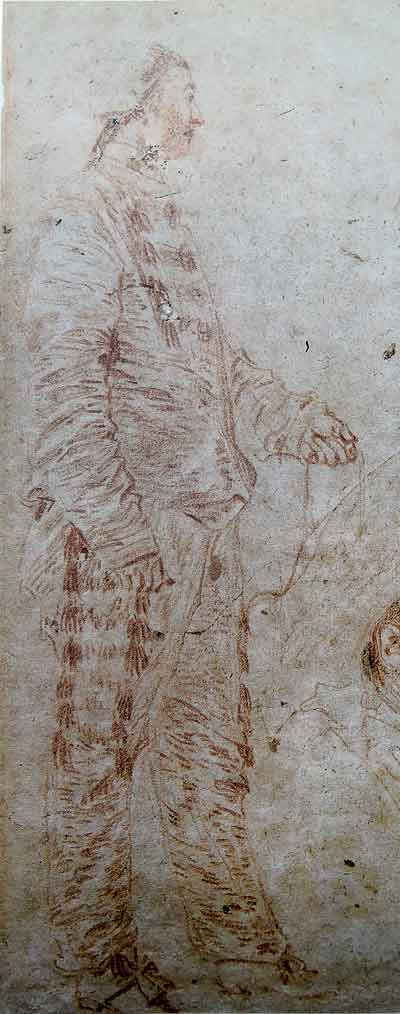
No drawing is known for the actor carrying a lantern at the left of the painting (probably to be identified as Brighella because of the horizontal stripes on his costume). It has frequently been noted that a Watteau drawing in the Musée Bonnat in Bayonne (Rosenberg and Prat 516) shows the same character in the same costume and he too is carrying a lantern. However, that figure is posed differently, with a more upright carriage and the lantern held in the opposite hand. It seems likely that Watteau made more than one study of this actor and he used one of those other studies for this painting.

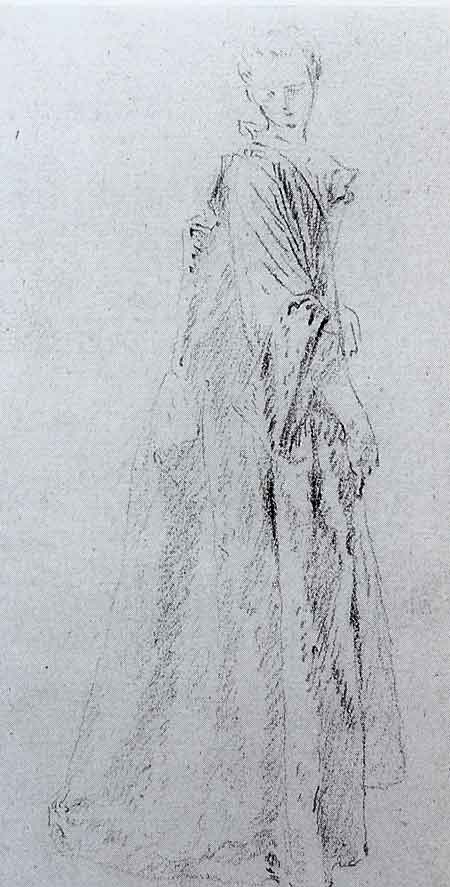
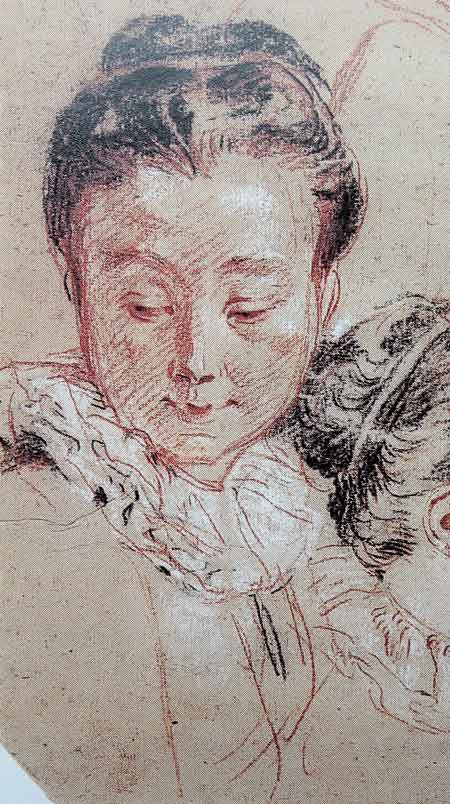
It has not been previously noted that a study of a standing woman (Rosenberg and Prat 108) apparently served for the actress at the left side of the painting, probably to be identified as Colombine or Isabelle. As was customary in his practice, Watteau referred to another study for a better definition of the actress’ head and ruff collar, in this instance the head in the lower left corner of a sheet now in the Louvre (Rosenberg and Prat 484).
The secondary actress, half-hidden in the background, does not appear in toto in any known Watteau drawing, although a good many sheets have similar studies of women with ruffs, posed peering forward. Her hands, one holding a mask and the other gesturing, have been traced to two different Watteau drawings. The hand holding a mask appears on a sheet of unrelated studies in a Parisian collection (Rosenberg and Prat 483), and the gesturing hand is found on a sheet in the Metropolitan Museum of Art that also contains a study of a woman’s head (Rosenberg and Prat 566).
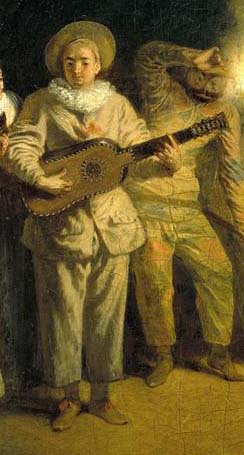
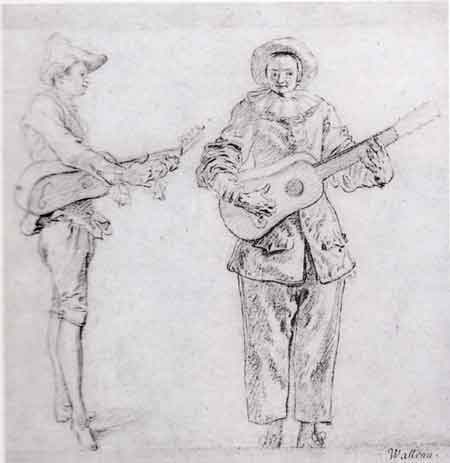
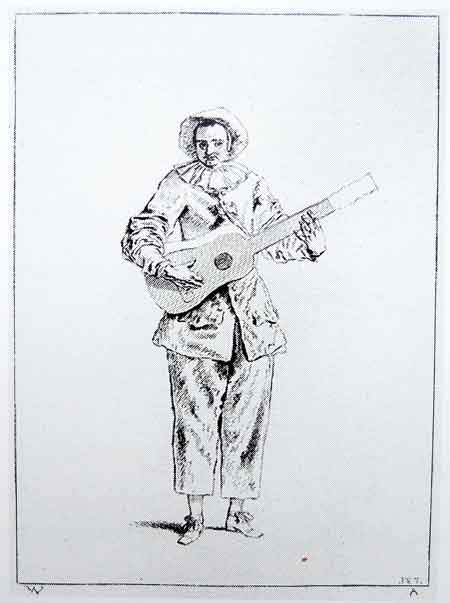
Until recently, the source of the empathetic figure of Pierrot standing at the center of L’Amour au théâtre italien had been traced to a sheet in a French private collection that also contains a standing figure of Mezzetin with a guitar (Rosenberg and Prat R159). Also it had been assumed that these figures were the ones engraved for the Figures de différents caractères, the Pierrot on plate 187 and the Mezzetin on plate 131. However, Rosenberg and Prat have rejected Watteau’s authorship of the drawing, claiming that it is too finely detailed for a mature work. (Yet the figure of Mezzetin was used for L’Enchanteur, a relatively early work.) Also, the mise en page of this sheet seems wrong. Watteau generally studied one or more models on a page in with changes of pose, but juxtaposing two separate studies of different standing Commedia dell’arte characters, both playing guitars, is without parallel. Rosenberg and Prat have also noted that normally all the figures on a sheet of studies were engraved by just one artist, yet in this instance two different men—Audran and Boucher—were responsible for engraving these figures. This is a serious objection, since Jullienne’s engravers followed this rule with a certain rigor. In short, it can be concluded that this double study is not from Watteau’s own hand. It is a copy, and the model that was redrawn here were the two previously mentioned engravings in the Figures de différents caractères.
But what were the models for the two plates in the Figures de différents caractères? Rosenberg and Prat argued that Audran and Boucher copied these characters from L’Amour au théâtre italien and L’Enchanteur. This thesis seems unreasonable and runs counter to what we know of the Figures de différents caractères, namely that the only sources for this publication were Watteau’s drawings or oil counterproofs (which are effectively drawings with paint). Instead, we would propose that the engraved figures were modeled on Watteau drawings that have not survived. Similarly, Watteau would have relied on this now-lost drawing for his painting. This is the simplest and most direct explanation.
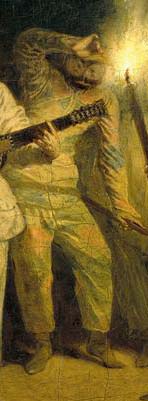
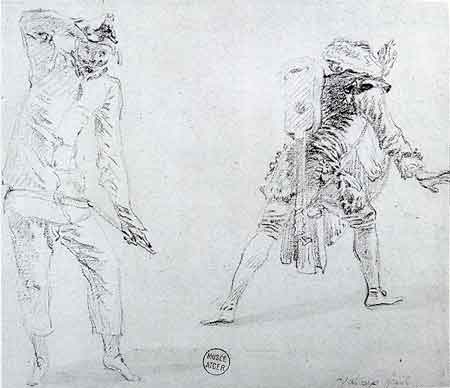
The figure of Harlequin, his hand to his head, is apparently derived from a rapidly rendered sketch of the clown at the left of a sheet in Montpellier (Rosenberg and Prat R355). Although this sheet has generally been accepted as by Watteau, Rosenberg and Prat also rejected it because it was “maladroit.” Here too they proposed that the drawing was based on the clown in L’Amour au théâtre italien and that the other figure on the Montpellier sheet was copied from an otherwise unknown Watteau painting. If these two images were copied from Watteau paintings, then should they not have the same degree of finish? But this is not the case. Like many of Watteau’s drawings made from life, one is drawn rapidly and the other is more fully delineated. The visual evidence argues in favor of the sheet being studies drawn from the live model by Watteau himself.

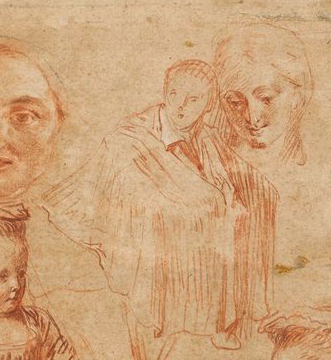
The half-length figure generally identified as Scapin, half hidden in the background and wrapped in his cloak, is taken from a Watteau sheet of studies in the Louvre (Rosenberg and Prat 229). The major lines of this character’s drapery are fully established, but the indication of his head is highly abbreviated. Watteau may have relied on another, separate study of the head, one where the angle of the face is more inclined and tilted to our left.
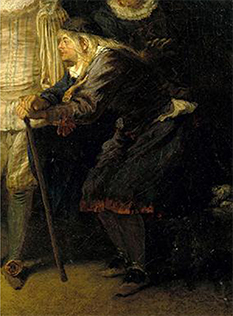
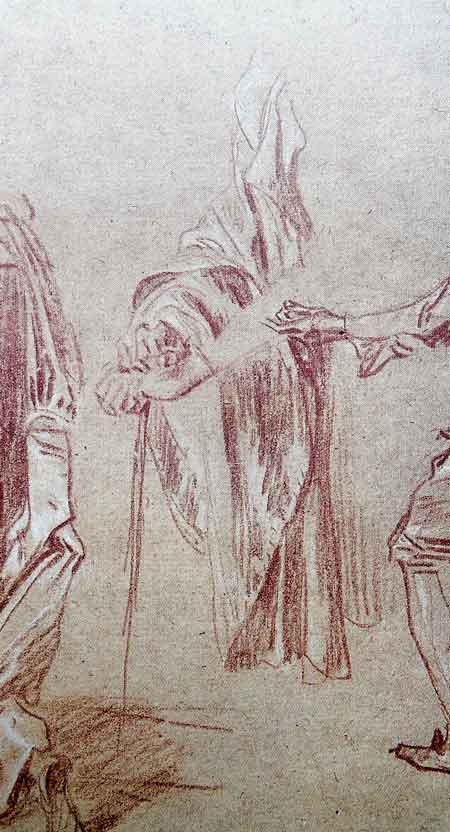
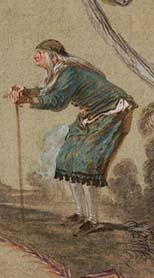
The hands and drapery of the aged actor at the left, often identified as Marcisino, are often said to be based on a detailed study of hands and drapery on a well-known sheet of drawings in the Louvre (Rosenberg and Prat 504). However, the actor’s costume and his hands are arranged differently in the painting. Even his cane appears at a different angle. Instead, Watteau seems to have relied on a lost, early full-length study from the model that he employed early in his career for a design for a fan, engraved under the title La Coquette and now in the collection of the British Museum.
Likewise there are no known drawings for several of the other figures at the left, nor for principal figures such as the Mezzetin holding a torch nor the Scaramouche at the right. Once again we are reminded of how few Watteau studies have survived.
REMARKS
As has already been discussed apropos of L’Amour au théâtre français, the date of L’Amour au théâtre italien is problamatic, and much has depended on how the two paintings are perceived as pendants. In the past the two works were dated the same way, but, especially since the 1980s, most scholars have come to agree that L’Amour au théâtre français was painted first, and L’Amour au théâtre italien was created later as its complement. There is no question but that L’Amour au théâtre italien possesses a more suave composition and richer figurative style. Its fewer, more corpulent figures occupy more of the pictorial space—a sure mark of Watteau’s mature style. Similarly, almost all the preliminary drawings associated with the painting are mature ones. Yet the unresolved issue, as always, is the year or span of years in which L’Amour au théâtre italien should be placed. Mathey was alone in assigning a date as early as 1714, but he also was under the misapprehension that the pendants had been painted together. Brookner situated the painting c. 1716, and when it was shown in Bordeaux in 1980, it was dated c. 1716-18. Börsch-Supan preferred c. 1717. Roland Michel, Posner, and Glorieux dated it c. 1718, as did the Ottawa exhibition of 2003. Adhémar dated it to 1719, as did the Paris exhibition catalogue of 1951. When it was shown in Munich in 1958, it was assigned to c. 1720. This wide spectrum of possible dates brings home the vagueness of Watteau’s chronology.
Various attempts have been made to identify the scene that Watteau portrayed here. In the early twentieth century Louis Fourcaud proposed that it was the end of the second act of Carnaval de Venise, which features a nocturnal setting with lanterns and torches. However, Dacier, Vuaflart, and Hérold suggested that it depicts a scene from L’Heureuse surprise, because that play, one of the first staged by the Riccoboni troupe after it was recalled by the Regent in 1716, charmed audiences with several nocturnal effects. Some scholars have accepted this identification, including Dora Panofsky, Macchia and Montagni, Mirimonde, and Temperini. But many others have argued against this association. If Macchia earlier seemed to embrace the identification of the painting with L’Heureuse surprise, in 1987 he rejected it. Nicoll was exceptional in claiming that Watteau created a wholly fictional image, especially because the Commedia dell’arte didn’t actually stage nocturnal tableaux. Taking a contrary stance, Posner abandoned the idea of trying to identify the play depicted, claiming that such nocturnal scenes were “not infrequent” at the Commedia dell’arte. Rosenberg thought the association “too strained.” So too, Glorieux was not convinced that there was any link between this specific play and the painting. Adhémar, Brookner, and Börsch-Süpan have bypassed the question entirely.
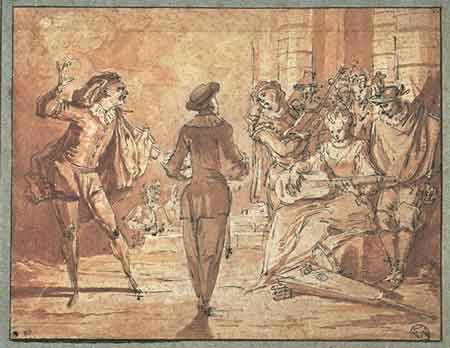
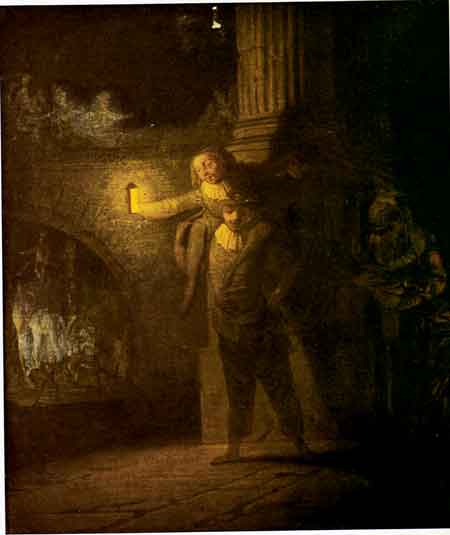
One of the dangers in these arguments is that they have focused too closely on just Watteau’s painting and have over-emphasized its uniqueness. Rosenberg, for example, wrote, “Not only is this Watteau’s sole nocturne, one of the rare paintings of a genre which, before Wright of Derby and Volaire, had but few practitioners in the eighteenth century.” This exaggeration overlooks the work of some of Watteau’s contemporaries, especially Jean Raoux, and even Lancret tried their hands at tenebristic works. More important, there are paintings by Watteau’s contemporaries that also depict the Commedia dell’arte with nocturnal settings, the most relevant examples coming from Gillot. One of his vivacious theatrical scenes, a drawing known as D’un fidelle valet because of the caption under the engraving after the composition, is a pertinent example. In this scene, a Pierrot stands in the foreground, his back to the audience, and he is thrown into shadow by an unseen but brilliant torch. The deep shadows at the outer edges reinforce the idea that this theatrical piece is being played as a nocturne. Among the rare paintings by Gillot is a theatrical scene now in the museum in Langres that depicts a parody of the fall of Troy in which Aeneas carries Anchises away on his shoulders. Harlequin plays the role of Aeneas, and Scapin takes the part of Anchises. Germane to our inquiry here, the scene is set at night, the light supplied by Scapin’s lantern.
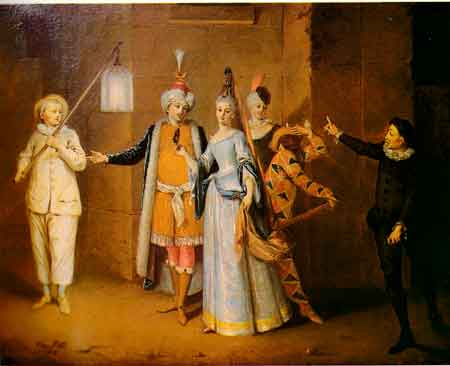
Also relevant is a Gillot painting in Algiers that shows another theatrical scene played by a Commedia dell'arte troupe. An actor dressed as a Near Eastern prince invites a young actress to depart with him, while Harlequin and Scaramouche strike the poses familiar to their roles and at the left, Pierrot holds a lantern to light the way for the eloping couple. Pierrot recalls the actor at the left of L’Amour au théâtre italien who performs a similar function.
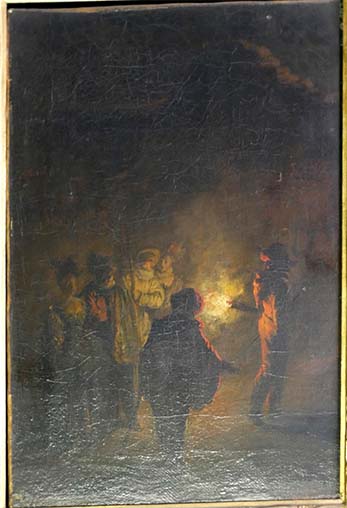
Also to be taken into consideration is a painting in Prague, Masquerade au clair de flambeaux. As far back as the early nineteenth century and perhaps even earlier, the picture was wrongly attributed to Watteau himself. It features a group of people dressed in Commedia dell’arte costumes and the light comes from both the moon and a brilliantly burning torch. Even though this picture was painted by one of Watteau’s followers who cannot yet be identified, it does appear to be from the first half of the eighteenth century and it reinforces the notion that images of nocturnal theatrical settings were not uncommon in the master’s time. The Prague painting has been interpreted as figures returning from a torch-lit parade or as people going out to the theater, but it would seem to be a theatrical scene with costumed actors in the same genre as Watteau’s.
For copies of L’Amour au théâtre italien, CLICK HERE

